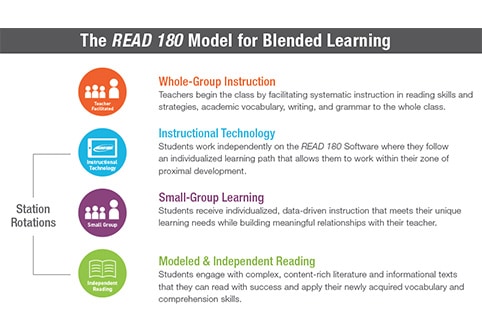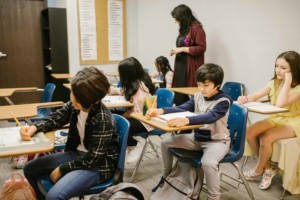Blended Reading Success in the Intermediate Grades

We met Cypress-Fairbanks principal Becky Koop at the Rice Education Entrepreneurship Program in Houston last week. She mentioned having “very good success” with READ 180, a blended learning reading program so we followed up to learn more.
Last year, Koop opened Pope Elementary in a beautiful new building in a new suburb of Houston. They used READ 180 in a full class model in 5th grade and an intervention model in 4th grade. Scholastic’s System 44 is used in special education and for the most challenged readers in Grades 3-12 who are not ready for READ 180.
Before Pope, Koop was principal of Matzke Elementary, a Title 1 school. They used READ 180 in 4th and 5th grade classes with struggling readers–half special education students with a significant number of English language learners.
In both locations she saw significant reading growth — more than a grade level. Some students have been below grade level and not passed state tests but showed a high pass rate after using READ 180. “It’s a great program for students with an ADD or ADHD,” said Koop.
“It is good teaching,” said Koop, “Even if you don’t use the READ 180 program, the blended model is great, It would make a great model to run a classroom.”
Four modalities. Most often deployed in a rotation model, the READ 180 program supports four instruction strategies (see featured image and this infograph for more):
- Whole group instruction: knowledge and vocabulary building strategies for educators and exemplary texts for students at multiple levels, both informational and literature.
- Small group learning: close reading of text, gathering evidence, and sharing their understanding and knowledge through a variety of research and writing tasks.
- Modeled & independent reading: students engage with a wide variety of literature and informational text; educators monitor student progress towards independence with complex, grade-level text.
- Adaptive learning: individualized practice in reading, spelling, vocabulary, and writing.
Koop finds the deployment model useful, “Kids can preview movies and things about the content to get background knowledge, then read and take tests on the computer.” Students use the spiral bound books as a supplemental tool. Teachers pulls struggling students out for a short period of time to give them more support.
Both schools use laptops to support the station rotation model. READ 180 is also available on iPads with some cool new features.
Cypress-Fairbanks uses READ 180 in secondary schools so there’s no risk of readers dropping off in middle grades.
“I will be honest with you, I think this is an awesome program,” said Koop. “I love seeing kids celebrate their successes; they come to love reading!”
For more, see:
Scholastic is a Getting Smart Advocacy Partner






0 Comments
Leave a Comment
Your email address will not be published. All fields are required.